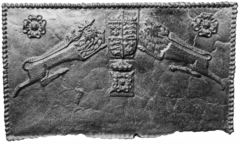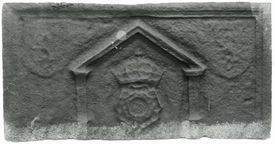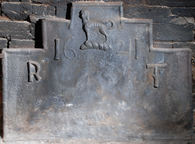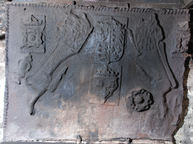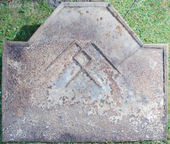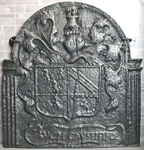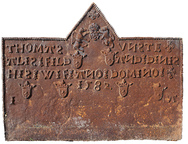-
450
Description: Rectangular; twisted rope edging; central crowned Tudor shield with lion passant guardant sinister to the left, and lion passant to right; four-petalled rose in right and left corners; crowned, barbed, four-petalled rose below shield.
Notes: One of a large series bearing some or all of the same stamps.
Arms: Tudor royal arms of England
- Decoration tags:
- rectangular (shape)
- rope (edging)
- carved stamps
- heraldic
- armorial
- animals
Manufactured: in the mid-16th century in the Weald area of England.
Current location: Barbican House, High Street, Lewes, East Sussex, England.
Museum number: LH000.800 (part of the Sussex Archaeological Society museum group)
Citation: Dawson, C., 1903, 'Sussex Iron Work and Pottery', Sussex Archaeological Collections, 46, pp. 1-54.
- Attached to series:
- Royal series
-
451
Description: Rectangular; twisted rope edging (top and sides); basic arrangement of crowned Tudor rose above a crowned Tudor royal shield, all between a crowned lion passant guardant sinister and lion passant, both per bend, repeated on both halves of the plate; irregularly arranged, mainly along the top and bottom, are sixteen small figures, alternately with right arm raised or lowered; bottom left and centre right are two different arrangements of a length of twisted rope in 'V' and 'I'.
Notes: The stamps used on this large fireback are encountered on several firebacks indicating their common source; previously at Legh Manor, Cuckfield, Sussex.
Arms: Tudor royal arms of England
- Decoration tags:
- rectangular (shape)
- rope (edging)
- simple stamps
- carved stamps
- heraldic
- apotropaic
- armorial
- animals
- humans
- objects
Manufactured: in the mid-16th century in the Weald area of England.
Current location: Anne of Cleves House, Southover High Street, Lewes, East Sussex, England.
Museum number: LH000.937 (part of the Sussex Archaeological Society museum group)
- Attached to series:
- Royal series
-
1053
Description: Rectangular; cyma curve and fillet edging; crowned Tudor rose within a pediment resting on Tuscan pilasters and pedestals; faint impression of a shield bearing a lion rampant repeated in each top corner.
Notes: The width of this fireback may indicate that another fireback in this series was used as its pattern and the shields added before casting.
- Decoration tags:
- rectangular (shape)
- cyma curve and fillet (edging)
- carved stamps
- whole carved pattern
- heraldic
- architectural
- armorial
- royal
Manufactured: in the mid- to late-16th century in the Weald area of England.
Current location: Anne of Cleves House, Southover High Street, Lewes, East Sussex, England.
Museum number: LH000.954 (part of the Sussex Archaeological Society museum group)
- Attached to series:
- Miscellaneous royal firebacks
- Pedimented rose and crown series
-
945
Description: Rectangular with two-stepped top; twisted rope edging (top and sides) formed of short rope sections, with top vertical sections extending down beyond the join with the next horizontal section; top centre, stamp formed of a talbot statant guardant upon a wreath; date separated by crest stamp; initials below and separated by date.
Notes: The talbot crest has been seen on other firebacks indicating a common source.
Inscription: 16 21 / R T
- Decoration tags:
- stepped (shape)
- rope (edging)
- simple stamps
- carved stamps
- individual letters
- individual numbers
- heraldic
- text
Manufactured: in 1621 in the Weald area of England.
Current location: in private hands, Lindfield, West Sussex, England.
- Attached to series:
- Talbot crest series
- Stepped firebacks
-
463
Description: Fragment; rectangular; twisted rope edging (top and side); top centre, crowned Tudor royal shield (over-pressed) above a crowned shield (over-pressed) bearing initials above a fleur-de-lys; to left, a leopard passant guardant sinister diagonally position with its rear toward the bottom left corner; to right, a leopard passant, also diagonally positioned, its rear towards the bottom right; in the top corners, a crowned four-petalled rose (over-pressed); below the left rose, a left-directed ‘imp’ figure looking right, its arms lowered; bottom right, a left-directed ‘imp’ figure, its left arm raised; to right of the lower shield, a four-petalled rose askew.
Notes: One of the ‘Royal’ series.
Arms: Tudor royal arms of England
- Decoration tags:
- rectangular (shape)
- rope (edging)
- carved stamps
- heraldic
- armorial
- royal
- animals
- humans
Manufactured: in the mid-16th century in the Weald area of England.
Current location: in private hands, Little Horsted, East Sussex, England.
- Attached to series:
- Royal series
-
465
Description: Rectangular with three-faced arch; ogee moulded edging; top centre, overlapping, crossed staples arranged diagonally, each pointing to a bottom corner.
Notes: The crossed staple is the badge of the Nevill family, and this fireback came from Eridge Park, the seat of the Marquess of Abergavenny.
- Decoration tags:
- rectangular with three-facetted arch (shape)
- cyma reversa/ogee (edging)
- simple stamps
- heraldic
- objects
Manufactured: in the 18th century possibly in the Weald area of England.
Current location: in private hands, Little Horsted, East Sussex, England.
- Attached to series:
- Personal firebacks
- Metalware stamp firebacks
-
1272
Description: Arched rectangular shape with side pilasters; cavetto-moulded edging to the arch; quartered shield with an, off-centre, knight's helm, wreath and mantling, and crest of a cubit arm vested, or habited, cuffed and erased holding an arrow in bend sinister; the shield has, in the 1st quarter three lions rampant, in the 2nd a bend cotised, in the 3rd possibly a lion rampant, and in the 4th possibly a dragon rampant within a bordure indented; motto below the shield.
Notes: From the style of the mantling the pattern carver may have also been responsible for other firebacks from the west Midlands or Welsh border area.
Copies of this fireback are known.
Inscription: SVCH CAVSE I FIND
Arms: Not known
- Decoration tags:
- rectangular with round arch (shape)
- cavetto (edging)
- whole carved pattern
- heraldic
- armorial
- text
Manufactured: in the early- to mid-17th century in England.
Current location: Littlehampton Museum, Manor Road, Littlehampton, West Sussex, England.
Museum number: A263 (part of the Littlehampton Museum museum group)
- Attached to series:
- Herefordshire armorial series
- Personal armorial firebacks
-
472
Description: Rectangular with central triangular arch; twisted rope edging (top and sides); in arch, on top, a small cross formed of fleurs-de-lys above a rose and crown with dragon and lion supporters above two crowned shields each bearing a small fleur-de-lys; text across top half, a small cross formed of fleurs-de-lys ending the first and third lines, the top two lines split by the crowned shields, each word separated by two opposed fleurs; below the text, four crowned shields each with a fleur-de-lys, the date between the middle two; lower left, 'I'; lower right, 'A'.
Notes: The inscription can be interpreted as Thomas Anstie alias Field and Denise his wife (etc.), the surname Anstie alias Field being known in the 16th century in central Sussex. A Thomas Anstye married Denys Joyner at Wivelsfield, Sussex on 5th June 1564; illustrated in Lower, 1849 p. 189 with some errors in transcription of the inscription; formerly at 'Misfield' (Miswell), Worth, Sussex. One of a small series of distinctive firebacks cast in 1582, most with inscriptions dedicated to pairs of individuals; the initials IA are likely to be of the founder as they appear in the same arrangement on the other firebacks.
Inscription: THOMAS VNSTE / ALIS : FILD AND DINIS / HIS : WIF: ANO : DOMINO: / 1582 / I A
- Decoration tags:
- rectangular with triangular arch (shape)
- rope (edging)
- carved stamps
- individual letters
- individual numbers
- heraldic
- text
Manufactured: in 1582 possibly at Pounsley Furnace, Framfield in the Weald area of England.
Current location: Gwesty Seren Hotel (formerly Bryn Llewellyn), Allt Goch, Llan Ffestiniog, Gwynedd, Wales.
- Attached to series:
- Pounsley series
- 1582 IA series
-
469
Description: Quasi-rectangular; edging formed of repeated bordered strip with undulating vine with fruit and leaves; horizontal line of two uneavenly repeated vine strips dividing the plate into two compartments, the upper comprising a grape bunch repeated eighteen times, the lower comprising a bird (probably a swan, a Lancastrian badge), its head turned to its left and one visible wing displayed and inverted, repeated five times with a grape bunch repeated twelve times at the ends and between each swan on the top and bottom of the compartment.
Notes: The vine strip, swan and grape bunch stamps feature on many firebacks indicating a common source. Illustration from Lloyd, 1925.
- Decoration tags:
- rectangular (shape)
- trailing vine (edging)
- simple stamps
- carved stamps
- heraldic
- animals
- plants
- objects
Manufactured: in the mid- to late-16th century possibly at Pounsley Furnace, Framfield in the Weald area of England.
Current location: not known.
Citation: Lloyd, N., 1925, 'Domestic Ironwork I', Architectural Review, 58, pp. 58-67.
- Attached to series:
- Pounsley series
- Vine strip series
- Swan series
- Furniture stamp firebacks
-
1060
 ? x ? mm
? x ? mmDescription: Central shield bearing a lion rampant reguardant, with esquire's helm and crest of a seated hawk, surrounded by foliage and tasselled ribbons; twisted rope edging at each side; the shape of the fireback is dictated by the decorative elements; initials split by shield, the date similarly split below the initials.
Notes: Drawing of a fireback from old premises, formerly a baker's, opposite 20 Love Lane (later known as Lovat Lane), which ran between Eastcheap and Lower Thames Street; the arms appear to be those of the Morrice family (blazon: gules, a lion rampant reguardant or). Drawn by Charles Raymond Booth Barrett, 1891. A fireback of unique design.
Inscription: W M / 15 86
Arms: Morrice or Maurice
- Decoration tags:
- complex individual (shape)
- complex individual (edging)
- whole carved pattern
- heraldic
- armorial
- text
- plants
Manufactured: in 1586 possibly in the Weald area of England.
Current location: not known.
Museum number: SC/GL/PR/370/LOV/1/q7706298 (part of the London Metropolitan Archives museum group)
Citation: Windyer Morris, G. T., 4 Oct 1902, 'Arms on Fireback', Notes and Queries, 9th series, 10, p. 278.
- Attached to series:
- Date & initials firebacks
